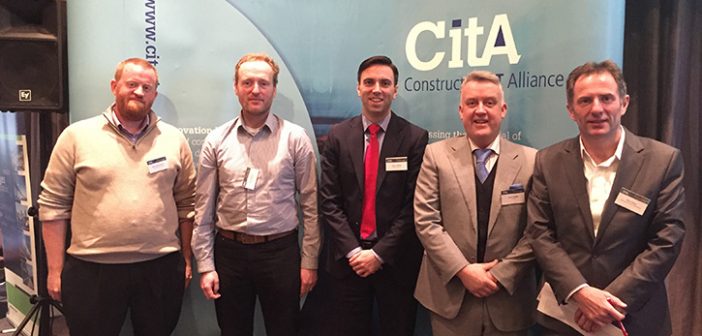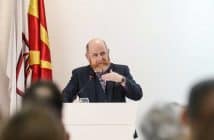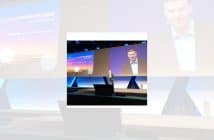The CitA Smarter Co-operative Building Series is a unique collaborative agreement between CitA and the constituents of the Construction Industry Council (CIC). Two meetings have already taken place thus far in 2016. Here we will identify what these meetings offer attendees, look back at the recent meetings and look at what is planned for the next four meetings in 2016.
2016 CitA Smarter Co-operative Building Series
CitA’s Smarter Building Series is a most relevant series for construction professions wanting to adopt BIM in their business and to stay up-to-date on the digitalisation of the construction industry. The breakfast meeting series is not just for learning about BIM and the use of technologies in construction, it offers opportunities for companies and individuals to network and grow their businesses.
The CIC members: The Association of Consulting Engineers in Ireland, The Building Materials Federation, The Construction Industry Federation, Engineers Ireland, The Royal Institute of the Architects of Ireland and The Society of Chartered Surveyors Ireland are event partners for the Series. Its sponsors are prominent high-profile companies.
From past meetings, it is obvious that there is a coming together of building professionals, experts and academics to discuss BIM and other technologies in construction. The speakers are always experts and industry leaders, and this is evident from this year’s meetings. All of the breakfast meetings, generally starting at 7.30am and concluding around 10.30am, are held at The Gibson Hotel, Point Village, Dublin 1. The Gibson, with excellent facilities and a great view of Dublin from its upper floors, has been praised by attendees of CitA meetings and conferences.
Building Momentum by Working Together
The 1st CitA Breakfast Meeting of 2016: ‘Building Momentum by Working Together’ was held on February 10th. This opening event sought to set the context for the Series.
BIMIreland.ie asked Dr Alan Hore about how CitA selected the speakers. He said ‘I had seen Paul Doherty of the Digit Group present at the RTC Conference in 2014 and I was very impressed. Paul provided the ideal “big” message on why we need to work together by selecting smart technologies to create great buildings and infrastructure. I met Brendan Keane of Intel at the CitA BIM Gathering and was aware of his involvement with the Construction Client Forum (CCF). Brendan was keen to find out more about our BIM Innovation Capability Programme (BICP) project and was willing to reach out to CitA to see if we would assist in raising the value proposition for BIM for clients within the CCF. Given that CitA will be carrying out significant research over the next few years, it was great to hear from Joern Ploenning’s Smart Cities research work in IBM and also from Luis Blane from NUIG who spoke of university-industry collaboration in BIM related projects to develop useful tools and frameworks for industry.’
The opening address was given by Carole Pollard, President of the Royal Institute of the Architects of Ireland (RIAI). Carole was the Chair of the meeting. Paul Doherty was the keynote speaker, and he was up first. Paul has a prolific CV. He is Chairman of theBIMcompany, President and CEO of the digit group, inc., and Co-Founder of the AEC Hackathon. Paul did an in-depth interview before the meeting with BIMIreland.ie which you can find on the website.
Paul’s presentation was titled: ‘BIM 2.0: Building Digital Momentum for Ireland’s AEC Community’. It was a session that challenged Ireland’s AEC Community to rise above the ‘But, that’s how we have always done it mentality’ to change workflows, processes, contracts and methods to meet the market demands of Smart Buildings and Smart Cities. Paul has worked in the development of design software. He has expertise on AEC software requirements and the potential of BIM. He gave an excellent talk on BIM and technology and how it can and will be applied to our built environment. Paul spoke about his work in designing smart cities. He talked about the inefficiencies in construction and how they can be eliminated. The world is fast changing and cities will host a large percentage of the world’s population, so they will have to be smart, sustainable and efficient. Paul talked about cities that were designed ‘from scratch’. Paul covered health requirements, services, schools, and housing. People are comfortable with traditional ways because they are safe. He talked about his work in America, Dubai, Australia and China. His talk focused on the requirements of entire cities, not just the individual buildings within. Paul compared the operation and function of a city with those of the human body, using Leonardo da Vinci’s Vitruvian Man in his presentation slides.
Paul, describing one of his projects, costing $114 billion, as ‘the largest construction project in the history of the world’, and is privately funded. He said it is a global industry project.
AEC Hackathons are becoming popular. Paul described the collaborations between AEC professionals, computer engineers and software engineers. Considering the technology incorporated into buildings now and the technical detail shown in Paul’s presentation, these professions will be working together a lot more in the future.
Brendan Keane of the Construction Client Forum (CCF) was the next speaker. The Construction Client Forum is responsible for: Standardized Industry KPI’s; Procurement lifecycle improvements/synergies; Standardized Basis of Pricing approach; BIM Standardization; Shared Learning Repository; and Impact of Client specification on VfM (Value for Money). Brendan spoke about how the CCF was set up and came to work with CitA. The construction industry is embracing Lean Construction along with BIM, with the aim of making the industry more efficient. Brendan spoke of what BIM and Lean can bring to construction. It is not just about money, but time and the quality of work. Speaking about the ‘Ireland Construction Industry Change Enabling Groups’ Brendan spoke about the setting up of Lean Construction Ireland and the Academic Forum. The collaboration between academia and industry will be beneficial to the built environment. The main goal of Lean is to increase value, and there is significant interest from contractors. Educating the client is critical in both Lean and Building Information Management. Brendan said educating the client in the value of Better Information Management ‘BIM’ for overall project performance is key. The core message of his presentation was that ‘Clients are eager to lead the transition to digital construction. Client education and training are required to enable that transition.’
Joern Ploennigs was the next speaker. Joern is a Research Scientist at IBM Ireland. His talk was titled ‘From BIM to Cognitive Buildings’. He said BIM is seen as a big enabler in the implementation of the Internet of Things (IoT). He said BIM will be a reference model for work to be done with Internet of Things. The work of IBM and Smart Cities is well known. IBM has about 100 researchers focusing on Smart City problems such as energy, water, traffic. They want to link all the data elements together and see BIM as a key element to this.
Joern talked about software and the business models for software, he linked this with BIM and said how companies would see it as steady income because the living model would be used over the lifecycle of the building, creating a sustainable income for the software company.
It is obvious why a company like IBM is interested in BIM. He said the company was not just interested in the 3D visualisation but the data, which can be of use. He talked about retrofit of building stock and using the data for the facilities management. For existing buildings, data can be captured by scanning. He used the example of an IBM data centre which is being surveyed for to make a model. Like the presentation at the 2015 CitA BIM Gathering by IBM’s Dr Claire Penny, Joern talked about cutting-edge technology and what we can expect in the near future with devices and augmented reality. He described how building data will be collected and analysed in a cognitive buildings environment. A cognitive building will be understanding of the environment, the requirements and what is going on inside the building through IoT.
Luis Blanes of the National University of Ireland, Galway (NUIG) gave a presentation titled ‘Building/HVAC energy models (BEM) from building information models (BIM).’ Luis is an Architect and an experienced researcher. He described his research at NUIG. He spoke about energy systems and HVAC systems, the use of calibrated building models to support operation and energy management of buildings. BIM is growing internationally, and Britain’s 2016 BIM Mandate was mentioned in the presentation. Luis emphasised what potential there is for using BIM data and improving BEM inputs. He also spoke about using BIM for the lifecycle, with post-occupancy calibration. BIM for the lifecycle of buildings is a reoccurring topic. How a building’s data can be used was mentioned here again. Luis described how to efficiently generate building energy models from BIM data and avoid duplication. The ultimate aim is to use BEM in design-stage solutions, the procurement stage, and in BEM performance-based contracting.
The meeting concluded with an interactive Q&A session and the closing address. After, talking about his experience of the CitA meeting with Irish building magazine, Paul Doherty said ‘Presenting at the kick off of CitA’s Breakfast Series was an honour to be part of. Listening to the Irish AEC industry and learning about the great progress Ireland is making in regards to BIM and other innovations was inspiring. I look forward to becoming part of the Irish AEC industry this year where we can learn and grow together.’
The Role of Digitisation in Propelling Irish Architecture
The 2nd Breakfast Meeting of 2016: ‘The Role of Digitisation in Propelling Irish Architecture’ took place on March 9th. For this meeting, CitA partnered with the RIAI.
We asked Alan Hore about the selection process for speakers for this event. He said, ‘The local speakers were selected by the RIAI. The RIAI were keen to include both a medium and micro-sized architectural practice. The keynote speaker Paul Dodd was selected due to his particular involvement in the Scottish Futures Trust (SFT) BIM Implementation Plan in 2015. This connection will greatly assist us in our own BICP journey.’
Alan Hore welcomed attendees, speaking about the BICP and the progress made to-date. Daniel Daye chaired the meeting, and opened it on behalf of the RIAI and spoke about the role of the RIAI in making sure BIM is implemented. The RIAI has long been supportive of CitA’s work. Dan spoke of his experiences and of how BIM has created opportunities for small architectural practices and said that architects must embrace BIM to get work internationally. He then welcomed
Paul Dodd the first of the morning’s speakers
Paul works for the Scottish Futures Trust (SFT), an independent company established by the Scottish Government. This organisation has a responsibility for delivering value for money in public sector infrastructure investment. Paul is currently involved in implementing the recommendations of the ‘Review of the Scottish Public Sector Procurement in Construction’. Paul spoke about some of the projects the SFT is involved in. He reviewed public procurement and spoke of the challenges and significant savings in introducing BIM. Paul talked about the Scottish Implementation Plan and the Scottish road map to BIM Level 2 in April 2017 and the BIM Implementation Plan. In Scotland, there have been three pathfinder projects set up. His advice for Ireland in implementing BIM was to’ Keep it simple’ and avoid acronyms, saying that BIM is ‘fundamentally information management’. Scotland is ahead of Ireland on the BIM Journey and it was interesting to hear Paul speak of the challenges and benefits that BIM can offer.
Paul concluded by telling attendees to utilise what good work currently exists, and to not ‘reinvent to wheel’. He said Scotland is not alone on the BIM Journey and would be willing to share their experiences with Ireland. He stressed that approaches need to be tailored to clients and local needs. Paul took questions from attendees on how Ireland could learn from Scotland.
Gary Mongey of Box Architecture was the next speaker. Gary’s practice, founded in 1997, has multiple awards for a variety of projects. Gary started with BIM in 2007, and he talked about the learning curve and cost associated with BIM. He showed attendees what he had done on projects. His presentation was of great interest to small practices. ‘You have to jump in at the deep end’, he said regarding BIM adoption and that BIM ‘takes the mundanity out’ of what architects do. Speaking about the requirements, Gary gave advice on what BIM offers, showing great section detail examples in BIM and visualisations. He said BIM is easier to do detailing with, but emphasised that ‘it’s a tool, not a design machine’ and will not automatically produce results. He concluded talking about the available online resources and stated how BIM saves time, gets a better client brief, and contractors can work better using it.
Tony Reddy and William Power of Reddy Architecture and Urbanism were the next speakers up. Tony told attendees about his career and the expansion of his practice to London in the last decade. Tony spoke of his commitment to BIM and what it offers architecture. He started the BIM Journey in 2007. Reddy has offices around Ireland, and Tony described some of his recent projects in Ireland and the UK. He said BIM has given the company many advantages.
William Power gave a memorable presentation at the CitA BIM Gathering in November. At the breakfast meeting, he talked about Reddy’s work and BIM adoption. He talked about his journey as an architectural technician and BIM Manager. He said of the traditional way of undertaking works: ‘The same old thinking, gets the same old results’. He also talked about Autodesk Revit and NBS Create. His presentation was technical and interesting to the viewers. Regarding the adoption of BIM in Ireland, the message from Tony Reddy was that ‘We need to get on with it’.
In the Q&A session, there were questions about what we can learn from Scotland for Paul, the difference between working in Ireland and the UK for Tony and William. Tony Reddy responded to a question, saying that contractors are responding positively to BIM.
Dr Louis Gunnigan, of Dublin Institute of Technology, identified a problem he had witnessed in industry, saying that there was no coordination of designers inputs into the model from the early design phase. He also questioned how successful the transfer of information from the model into Facilities Management software was after the construction phase. William Power said a BIM Coordinator is essential on projects. BAM’s Michael Murphy said that contracts need to be realigned with BIM and that this is a problem. The problem of traditional contracts is a big problem for BIM adoption.
Alan Hore brought the meeting to a close with thanks to the speakers and attendees. CitA had a live feed on Livestream, and CitA’s Eoin Rogers Tweeted from the meeting while interacting with attendees, remote viewers and others on Twitter. The organisation of the meeting by CitA was praised on social media.
What is next in the Series?
The remaining meetings will take place in May, June, September and October. Alan Hore provided us with the following details:
May – Engineering:
Civil, structural, building services engineers will come together in one unique setting to demonstrate the value proposition of BIM for Irish engineers. CitA is also delighted to announce that Ronan Collins, Managing Director of InteliBuild, based in Hong Kong, will be returning to Dublin to provide the keynote address.
June – Construction:
In a unique partnership between the CIF and the CIOB (Chartered Institute of Building) learning how contractors are gaining the most traction with BIM in Ireland. The key project-related benefits include reduced errors, omissions and reduced rework. Irish contractors will also share the benefits of reduced construction costs, reduced project duration and improved project safety.
September – Surveyors:
The SCSI and the RICS (Royal Institution of Chartered Surveyors) will team up to demonstrate the value proposition of BIM for a variety of surveying disciplines.
October – Manufacturers:
This Building Material Federation will host an event that will seek to demonstrate the opportunities inherent in BIM, which allow the full realisation of the benefits of linking design, project and manufacturing information. It will also include the presentation of case studies from manufacturers that demonstrate the integration of BIM data and manufacturing technologies to supply the products and solutions for a sustainable built environment.
If you want to find out more about the Smarter
Co-operative Building Series, please contact General Manager Suzanne Purcell: spurcell@cita.ie




